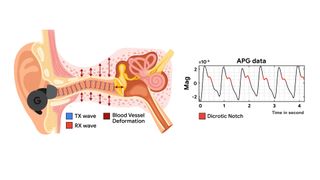Future Pixel Buds could get heart-rate tracking thanks to Google breakthrough
In a recent post on its Research blog, Google revealed that it has discovered a way to detect a person’s heartbeat through active noise canceling (ANC) earbuds.
The method is called Audioplethysmography (say that three times fast), or APG for short. The way it works, said the technology giant, is that the ANC earbuds send a “low-intensity ultrasound signal through” the speakers. The signal then bounces around in the ear canal, sending the echo back to be received by the ‘built-in feedback microphones’. The echoes are affected by “small skin movements in the ear canal and heartbeat vibrations”.
The company was able to detect both the heart rate within the feedback signal and the heart rate variability. They could see whether the heart was beating fast or slow. Google explains in its post that the ear canal is “an ideal location for health sensing” thanks to all the blood vessels that pass closely through that part of the body.
Surprisingly accurate
As part of its research, Google conducted two rounds of research with a total of 153 participants. Their results show that the ANC earbuds were able to accurately detect heartbeats with a low margin of error of approximately 3.21 percent. Apparently, the devices could even complete their task when music is playing and outside sound leaks in. Furthermore, the technology is not affected by different skin tones or different ear canal sizes. It all works the same.
APG is not perfect because it could be “heavily disrupted by” body movements, which could greatly limit its implementation in future devices. However, Google remains hopeful as it believes this technology is better suited to earbuds than your standard electrocardiogram (ECG). The reason why the latter has not been added to headphones is that it would “add cost, weight, power consumption, (design) complexity and form factor challenges,” preventing widespread adoption.
A work in progress
The question now is: will we see APG in the next generation of Pixel Buds or any earbuds for that matter? Maybe. It certainly has a lot of potential for health-conscious users who want to track their heart rate but might not want to commit to purchasing a Pixel Watch 2 or a fitness band. Additionally, the company claims that it could make ANC headphones support APG with a “simple software upgrade.” So what’s the delay?
Well, it’s still a work in progress. If you the full article on Google Researchthe next big steps are to improve APG’s performance in rigorous exercise including, but not limited to, walking, weight lifting and boxing. The team behind the APG also hopes that the findings can be used in other experiments.
Google explains that ANC headphones use “feedback and feedforward microphones” to function. These microphones have the potential to open up “new possibilities” for other applications in medicine, from monitoring a person’s breathing to diagnosing ear diseases.
Until we know more, check out Ny Breaking’s list of the best fitness trackers for 2023.

